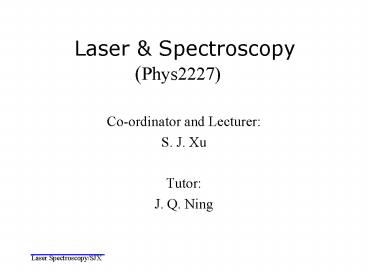Laser - PowerPoint PPT Presentation
1 / 11
Title:
Laser
Description:
Laser Heroes: Gordon Gould, Charles Townes, Arthur Schawlow, Theodore Maiman ... In 1954, Charles Townes and Arthur Schawlow invented the maser (microwave ... – PowerPoint PPT presentation
Number of Views:35
Avg rating:3.0/5.0
Title: Laser
1
Laser Spectroscopy(Phys2227)
- Co-ordinator and Lecturer
- S. J. Xu
- Tutor
- J. Q. Ning
2
Contents
- Introduction
- Fundamentals
- Lasers as Spectroscopic Light Sources
- Components of Spectroscopic Instruments
- Spectroscopy of Solids
- Laser Raman Spectroscopy
- Selected Applications of Laser Spectroscopy
3
Text Books References
Text book Laser Spectroscopy, E. R. Menzel,
(Marcel Dekker Inc., 1995). References Laser
Spectroscopy, 2nd, 3rd edition, W. Demtröder,
(Springer, 1996, 2003). Optical Spectroscopy of
Inorganic Solids, J. Garcia Sole, L.E. Bausa, and
S. Jaque, (Wiley, England, 2005). Photonics, R.
Menzel, (Springer, 2001).
4
Teaching Assessment
- 24 hours of lectures and tutorial classes
- One 2-hour written examination (50 weighting)
and continuous course assessment (30 weighting) - One experiment Low-temperature photoluminescence
(20 weighting)
5
Chap. 1 Introduction
- Why we study laser spectroscopy?
- Laser is one of the greatest inventions in
humankind history so far. - Laser is the most beautiful coherent light
source. - Laser has great applications.
- Laser spectroscopy has made us have so much
knowledge and deep understanding about light
itself, matter, and light-matter interactions. - Laser itself and laser spectroscopy are still
rapidly developing.
6
Chap. 1 Introduction
Laser Heroes Gordon Gould, Charles Townes,
Arthur Schawlow, Theodore Maiman
The name LASER is an acronym for Light
Amplification by the Stimulated Emission of
Radiation. In 1917, Albert Einstein first
theorized about the process which makes lasers
possible called "Stimulated Emission."
In 1954, Charles Townes and Arthur Schawlow
invented the maser (microwave amplification by
stimulated emission of radiation), using ammonia
gas and microwave radiation - the maser was
invented before the (optical) laser. The
technology is very close but does not use a
visible light.
7
Chap. 1 Introduction
Laser History
In 1958, Charles Townes and Arthur Schawlow
theorized about a visible laser, an invention
that would use infrared and/or visible spectrum
light. Theodore Maiman invented the ruby laser
considered to be the first successful optical or
light laser. Many historians claim that Theodore
Maiman invented the first optical laser, however,
there is some controversy that Gordon Gould was
the first.
Gordon Gould was the first person to use the word
"laser". There is good reason to believe that
Gordon Gould made the first light laser. Gould
was a doctoral student at Columbia University
under Charles Townes, the inventor of the maser.
Gordon Gould was inspired to
8
Chap. 1 Introduction
build his optical laser starting in 1958. He
failed to file for a patent his invention until
1959. As a result, Gordon Gould's patent was
refused and his technology was exploited by
others. It took until 1977 for Gordon Gould to
finally win his patent war and receive his first
patent for the laser.
The first gas laser (helium neon) was invented in
1960 by Ali Javan.
The carbon dioxide laser was invented by Kumar
Patel in 1964.
In 1962, Robert Hall created a revolutionary type
of laser that is still used in many of the
electronic appliances and communications systems
that we use every day. (Semiconductor Laser
Diodes!)
9
Chap. 1 Introduction
- What is laser spectroscopy?
- It is a technique that uses the interaction of
coherent light with a sample to perform an
analysis. - What can laser spectroscopy provide us?
- It provides information on the interaction of
coherent light with matter. - What features does laser spectroscopy have?
- It generally has high resolution and sensitivity.
10
Chap. 1 Introduction
- The Main Aim
- To provide a broad introduction to modern laser
spectroscopic techniques and selected
applications. - Outline
- Chap. 2 discusses the fundamental definitions
and concepts of laser and spectroscopy, such as
optical transition, absorption, emission,
radiation power and intensity, transition
probabilities and so forth. - Chap. 3 treats the fundamentals of lasers as
spectroscopic radiation sources. - Chap. 4 covers basic instrumentation and its
application to wavelength and intensity
measurements. - Chap. 5 talks about laser spectroscopy and its
various high-sensitivity detection techniques. - Chap. 6 gives a discussion of laser Raman
scattering spectroscopy.
11
Chap. 1 Introduction
- Chap 7. illustrates by some examples of laser
spectroscopy applications.
We Study Together! We Gain Together!
Contact information of lecturer and tutor S. J.
Xu
J. Q. Ning Office R316 CYM Physics Building
Office G21 Tel 22415636
Tel 22415190 Email
sjxu_at_hkucc.hku.hk Email
jqning_at_hkusua.hku.hk Web Http//www.physics.hku.h
k/laser































